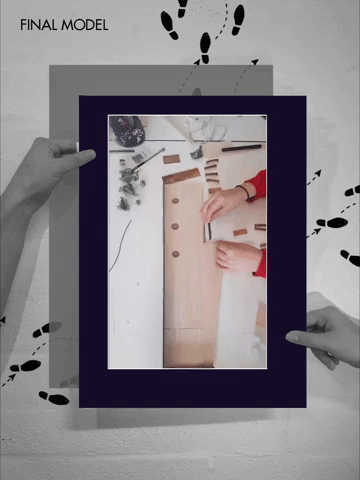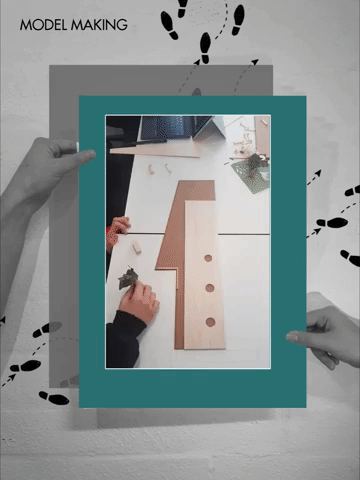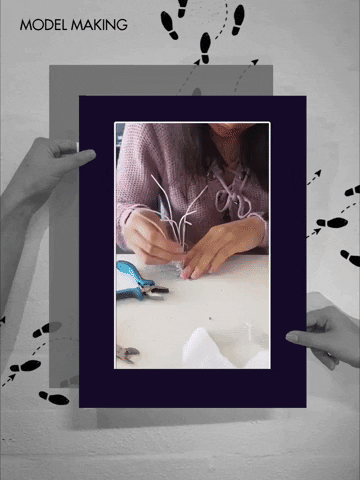GROUP 3 - FINAL POSTER
Group 3's final poster indicates their final proposed plan of the roof terrace. The series of collages on the poster also demonstrates the type of spaces created by the proposed design of the team.
Pods of different sizes will be placed at different part of the site where the entrance point for each pods were carefully calculated to improve privacy as well as create mini private gardens at different area of the terrace. The difference in pod sizes also provided opportunity for different activities to take place within each of the pods. For example, the larger pods will be used for BBQ and team bonding activities while the small pods can be used for meditation.
Besides that, the pictures also reflected the type of materiality as well as atmospheric pressure created by the proposed design. The whole terrace will provide an opportunity for the users to reflect upon themselves and get their mind off the hospital surrounding.
Posted 8 Apr 2019 10:06

Group 2 - STRUCTURAL DEVELOPMENT
Group 2 came out with their final proposal with the concept of the tree garden being integrated into part of the canopy structure. The 'tree trunks' was proposed to be constructed through timber joists while the canopy will be constructed through carbon fiber. The whole structure will generate a light and open environment to the whole roof terrace. Timber seating were also in cooperated as part of the structure to provide seating for the users.
The organic roof structure will also be built it repetitions of triangles where the same triangle language will be reflected to the pavement design on the roof terrace. The triangular pavement design will be used to provide guidance for the user along the site, creating a circulation path. The triangular pavement will be placed at strategic locations to create a 'fading' effect and to soften the boundary between the pavement and wetpour material used for the other parts of the site. Certain triangular formed grass patches were also integrated as part of the pavement design.
Posted 7 Apr 2019 08:44
Group 3
To prepare for the final presentation to AEW architects and Ronald McDonald House Manchester, group 3 have considered the following themes; Social; Individual; and Natural Materials.
The social concern that group 3 focused on is reflected in the open public walkways and stop off areas throughout the proposed site.
Individual zones are provided within the pods. These spaces provide the user with closed off, secluded areas for reflection.
Natural materials have been considered to introduce an element of calm. This aims to blur the barrier between the busy adjacent main road and a calm area for the users.
Posted 4 Apr 2019 17:51
Group 1: KJ, Beena, Jasper & Yasmine
Assembling of final presentation model at scale 1:50 which included canopy, landscape, urban furniture and vertical planting.
Urban furniture and roof canopy were added at the side of the canopy that overviews the existing garden to provide a pleasant environment for users to have breakfast and socialize while overlooking their children playing at the playground on ground floor. A dynamic canopy will also be added to half of the terrace to provide shading from the rain and control of sunlight for users that are sunlight sensitive.
Posted 4 Apr 2019 09:49
Group 3
Kilian, Nina, Brandon & Drilon proposed to have multiple pods that were scattered around the terrace to create different spaces.
The question regarding the flexibility of the pods were raised during the feedback by AEW and 5th years. The students were suggested to improve the flexibility of the design through the play of sizes, materiality and function of the pods. Pods of different sizes could be designed to provide different function where smaller pods will be more suitable for couples and larger pods will be more suitable for groups. The materaility of the pods were also a topic of discussion where students were suggested to play with both semi-translucent and completely covered materials. This will ensure different privacy level within each pods.
Last but not least, students were also asked to look into the positions of the pods within the site as well as play with the boundary lines between soft and hardscape to enhance the circulation through the terrace.
Posted 4 Apr 2019 08:39
MODEL MAKING
Group 1 decided to make their final model through a range of materials and skills. They were taught to prepare a CAD file for laser cut as well as directed by the 5th years to produced certain part of their final model using this method. They also decided to hand cut specific elements of the model.
Their design will consist a combination of both softscape and hardscape to create a pleasant journey for the user of the space. Vertical plantings and planter boxes were also in cooperated into parts of the design to create a peaceful environment.
Posted 3 Apr 2019 11:16
MODEL MAKING
Group 2 decided to make their physical model our of foam board, wire mesh and bendable metals.
Their concept that revolves a direct reflection of garden allowed them to explore tree like structures placed at strategic parts of the canopy in order to provide shading, privacy as well as control the viewpoints of the users. The structure of the trees will be constructed in the form of tree trunks with integrated public seating underneath it. The canopy of the trees were also proposed to be redirected the rain water in order to create a unique water feature at assigned area within the roof terrace.
Posted 2 Apr 2019 14:16
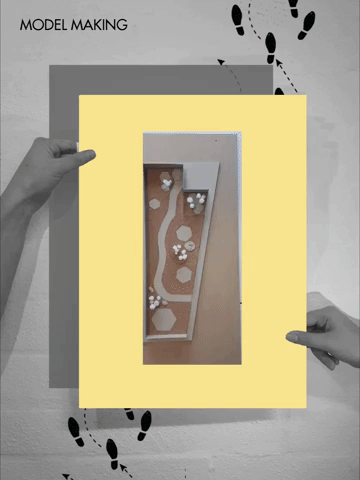
MODEL MAKING
Group 3 decided to make their final physical model at scale 1 to 50 to be used for the final presentation on Friday. They decided to hand build their physical model by using MDF, cork, balsa wood and cotton.
Individual pods were made using wood strips. These pods can be attached and detached from the site model to provide flexibility in terms of position and orientation for the user of the space.
Each pods were also designed slightly differently to provide different programs, user experience and privacy levels. For example, different pods were designed to enhance different sensory experiences like: sight, scent, touch and sound. This would in turn enhance the overall experience and provide an opportunity for relaxation to the user of the charity house. These elements will be achieved by the play of different pod sizing, spatial compositions, materiality and transparency setting where the students are still experimenting simultaneously with the model making process. This provides the element of choice to the user where user are allowed to pick the preferred pods to relax and meditate.
Posted 2 Apr 2019 13:23
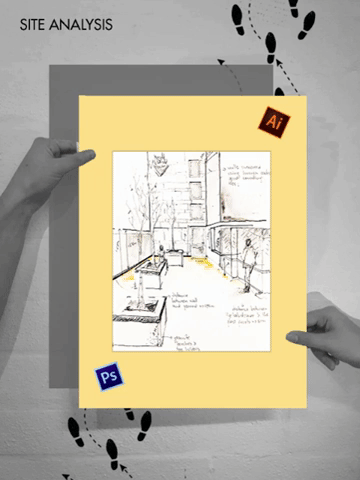
SITE ANALYSIS
Students were divided into groups of 3 or 4 with mixture of both 1st and 2nd year students. This will be the final grouping system where all the groups will now work towards producing a final output together as a team.
A large site map were then placed on the wall and every student were asked to give their opinions on the current condition of the site as well as elements that would affect the site, as seen in their site visit. These opinions were then diagrammed onto a singular site map that could act as their main guidance and generator for their personal site analysis.
Next, examples for analytical diagrams and methods of producing simple yet informative diagrams were also shown to the students. Students were then introduced to diagrammatic methods through the use of Photoshop and Adobe Illustrator by the 5th years. After that, students were asked to produce their own version of site analysis among their respective groups, which would be able to assist them in the next design stage, design development.
Posted 28 Mar 2019 16:29

SITE VISIT
All students were brought on a tour around Ronald McDonald House Charity by Mike to get a better understanding of the history, user and dynamics of the charity house.During this tour, the students were given the opportunity to take a peek into the lifestyle and needs of the occupants as well as emerge themselves into the daily life of the residents. This helped the students to gain a better understanding on the users, which will in turn assist them in their design process. Students are expected to reflect their understanding of the user requirements on their proposed design concept.
After that, all the students were brought to the roof terrace before being split into 3 groups with 3 different tasks to perform during the site visit, being:
Group 1: Measurement of the site (To get a better understanding on the scale of the site)
Group 2: Photographs of the site (Capturing the different viewpoint of the site)
Group 3: Sketching and notes of the site (Aim to capture the mood and atmosphere of the site)
The students were also taught by the fifth years to analyse the space in an architectural point of view. Previous design implementations and strategies were also pointed out to the students. For example, the previous landscape designer tried to enhance the circulation from the ground floor garden towards the roof terrace by having strips of green wet pour as part of the pavement pattern, thus creating an indirect movement guideline to the users. These green patterns are also reflection of the charity house facade by having the same geometric language and colour profiles. Besides that, the existing grid lines on the site were also enhanced by placement of large planter boxes and concrete seating arrangements. Students were then asked to sketch out their personal perception and viewpoints of the existing site before developing an initial concept for the space.
Posted 26 Mar 2019 16:27

Day 1 - Reading List Sketches
Having provided the key pieces of literature from the reading list that we had prepared for the first and second year students prior to our first meeting, we were able to engage in an in depth conversation between the students on their findings. The readings ranged from information on architectural pavilions, terrace design and theoretical research into spaces improving the health and well-being of its user.
We were all impressed with the contribution each of the students had with our discussion and the sketches produced will provide an excellent start to the conceptual design of the final output. Key analytical findings included consideration of materiality, form and user interaction that could be incorporated into the design of a terrace of reflection for the residents.
Initial mention of ‘organic forms’, ‘natural materiality’ and ‘acoustic buffering’ were coherent themes throughout the students findings which we found particularly interesting. It is clear the brief had been understood by each group member and the sensitive response to it was being taken on board. Architectural methods in designing peaceful and calming environments such as material choice, form and atmospheric controls were already being discussed. A great start to the design process!
Posted 26 Mar 2019 10:02

READING LIST
1. A Pattern Language
Describes an entirely new attitude to architecture and planning. It also provides a complete working alternative to our present ideas about architecture, building, and planning.
2.Serpentine Gallery Pavilion 2005
Serious of pavilion case studies.
3. Micro Very Small Buildings
Case studies with constraints of space where cost can liberate the imagination. Contain 5 thematic chapters: public realm, community spaces, on the move, compact living and extra spaces.
4. Aesthetics, Well Being and Health
Reflection on impacts of architecture and environmental aesthetics on their well being and health.
5. The New Pavilions
Containing more than 80 pavilion case studies for reasons of geography, variety and inventiveness. The image they define of contemporary architecture is far more relevant and revealing than any selected 'real' buildings.
6. Design for Health: Sustainable Approaches to Therapeutic Architecture
This issue of AD seeks out innovative and varied sustainable architectural responses to designing for health, such as: integrating sensory gardens and landscapes into the care environment; specifying local materials and passive technologies; and reinvigorating aging postwar facilities.
7. Healing Architecture
This title presents the fundamental principals behind the conception and design of built space and their effect on coping with illness. One of the key questions to be answered is how architecture can contribute to healing. Put another way, how does the environment, both built and unbuilt, influence the perception of healthy human beings, in order for them to remain healthy?
Posted 18 Mar 2019 18:22

The aim of this event is to aid in the conceptual re-design of the Ronald McDonald House Charity roof terrace at Manchester, turning it into a garden of reflection for the residents within the charity house. The designs of the terrace area should be guided and shaped by these 5 main principles:
1. Design for different activities of different energy levels
The activities and programmes of the terrace should be taken into consideration before subdividing the space into different spatial zones. The terrace design should aim to create a peaceful environment for the residents to reflect upon themselves and relief mental frustrations.
2. Create sense of space
The design should be able to create a sense of space and belonging for the residents within the Ronald McDonald House Charity. It should have a strong sense of place that speaks to the culture, location, and “spirit” of community.
3. Allow creativity and surprises to occur
The space designed should not be too generic but able to provide a sense of discovery. This will help in creating a complete narrative and a well rounded experience for the users of the space.
4. Consider the 'flow' of space
Resident movements and spatial compositions through the site should be taken into consideration to be able to come out with a proposal that allows different paths of exploration.
5. Work with site and nature
Paths, edges, boundaries and surrounding of the site should be analysed before the designing process. This will help to ensure the proposal to have a coherent language and continuous flow with the existing outdoor terrace and Ronald McDonald House Charity.
Posted 17 Feb 2019 16:35
Meet the group: Christine Guan
Posted 22 Jan 2019 19:28



